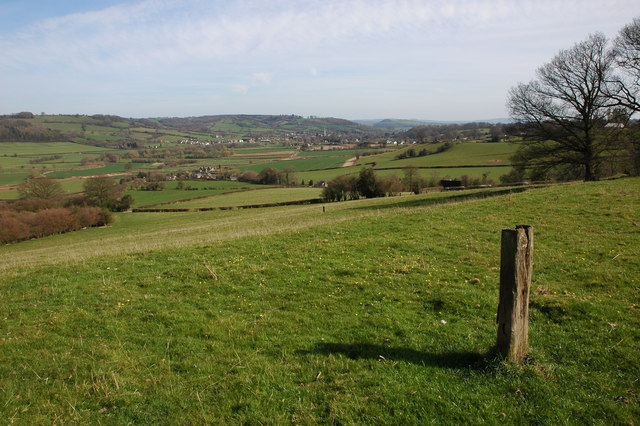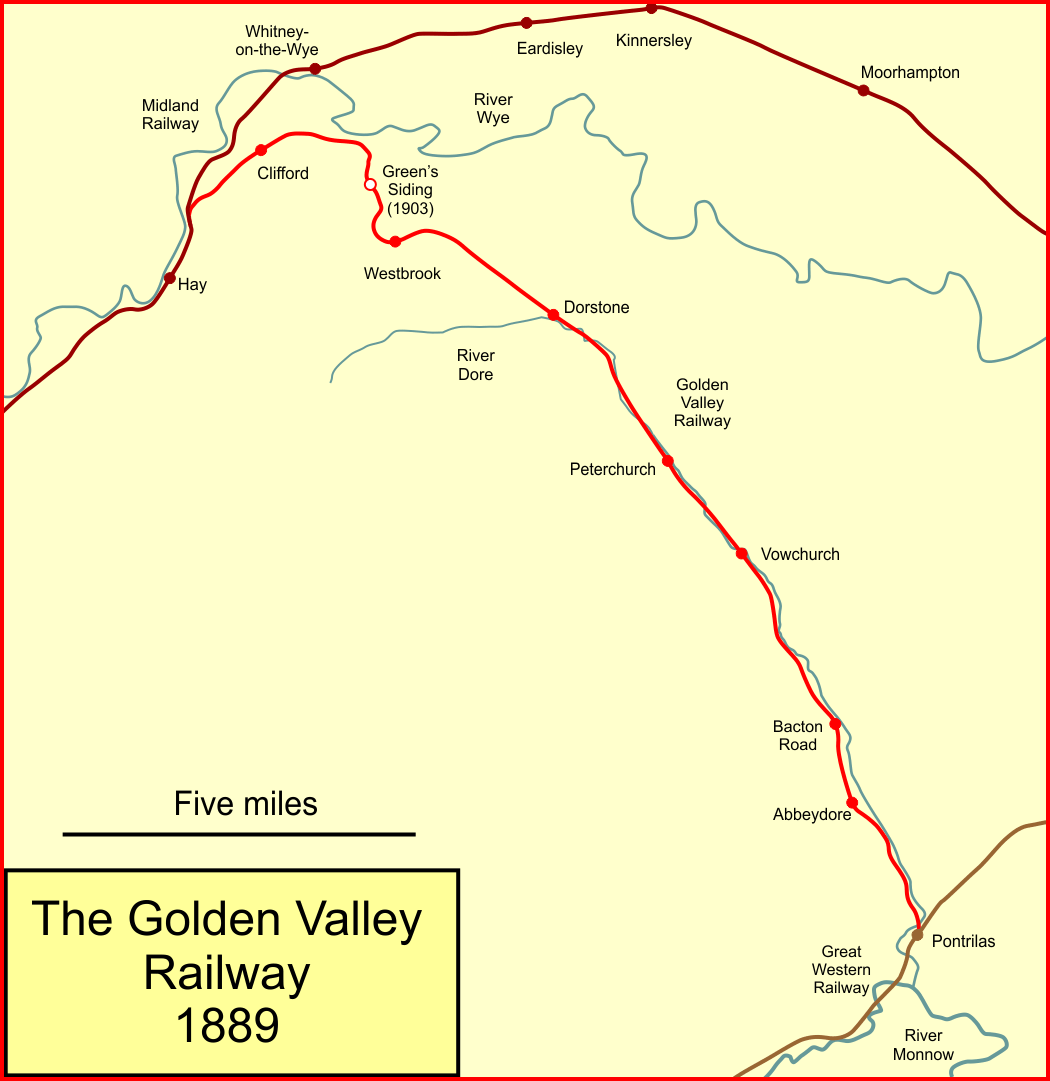|
Hay-on-Wye Railway Station
Hay was a railway station serving the town of Hay-on-Wye in Powys, Wales, although the station was located just across the English border in Herefordshire. Hay had one of the earliest railway stations in the country, being part of a horse-drawn tramway. Railway lines from Hay station The Hay Railway, a horse-worked freight tramroad, opened from the Brecon & Abergavenny Canal at Brecon to Hay on 7 May 1816. The line was opened from Hay to Clifford Castle on 30 July 1817. The line was not completed between The Lakes at Clifford and Eardisley until 1 December 1818 because of the problem of the river crossing at Whitney-on-Wye. The Hay Railway was sold in 1860 to the Hereford, Hay and Brecon Railway (HH&BR) which made use of parts of its route. The HH&BR was a struggling local line, much of it built by Thomas Savin, contractor and builder of many Welsh lines. It was completed in 1864. Like most local lines it was eventually rescued by a larger company – not the Great Weste ... [...More Info...] [...Related Items...] OR: [Wikipedia] [Google] [Baidu] |
Hay-on-Wye
Hay-on-Wye ( cy, Y Gelli Gandryll), simply known locally as "Hay" ( cy, Y Gelli), is a market town and community in Powys, Wales; it was historically in the county of Brecknockshire. With over twenty bookshops, it is often described as "the town of books"; it is both the ''National Book Town of Wales'' and the site of the annual Hay Festival. The population of the town in 1841 was 1,455; this had grown to 1,680 by 1901. The town has grown little since, with 2018 estimates at 1,900. The built-up area includes Cusop across the border in England and has a population of around 2,000. Location The town lies on the south-east bank of the River Wye and is within the north-easternmost tip of the Brecon Beacons National Park, just north of the Black Mountains. The town is just on the Welsh side of the border with Herefordshire, England, here defined by the Dulas Brook. Where the brook joins the River Wye just north of the town, the border continues northwards along the river. The Wy ... [...More Info...] [...Related Items...] OR: [Wikipedia] [Google] [Baidu] |
Great Western Railway
The Great Western Railway (GWR) was a British railway company that linked London with the southwest, west and West Midlands of England and most of Wales. It was founded in 1833, received its enabling Act of Parliament on 31 August 1835 and ran its first trains in 1838 with the initial route completed between London and Bristol in 1841. It was engineered by Isambard Kingdom Brunel, who chose a broad gauge of —later slightly widened to —but, from 1854, a series of amalgamations saw it also operate standard-gauge trains; the last broad-gauge services were operated in 1892. The GWR was the only company to keep its identity through the Railways Act 1921, which amalgamated it with the remaining independent railways within its territory, and it was finally merged at the end of 1947 when it was nationalised and became the Western Region of British Railways. The GWR was called by some "God's Wonderful Railway" and by others the "Great Way Round" but it was famed as the "Holiday ... [...More Info...] [...Related Items...] OR: [Wikipedia] [Google] [Baidu] |
Railway Stations In Great Britain Opened In 1864
Rail transport (also known as train transport) is a means of transport that transfers passengers and goods on wheeled vehicles running on rails, which are incorporated in tracks. In contrast to road transport, where the vehicles run on a prepared flat surface, rail vehicles ( rolling stock) are directionally guided by the tracks on which they run. Tracks usually consist of steel rails, installed on sleepers (ties) set in ballast, on which the rolling stock, usually fitted with metal wheels, moves. Other variations are also possible, such as "slab track", in which the rails are fastened to a concrete foundation resting on a prepared subsurface. Rolling stock in a rail transport system generally encounters lower frictional resistance than rubber-tyred road vehicles, so passenger and freight cars (carriages and wagons) can be coupled into longer trains. The operation is carried out by a railway company, providing transport between train stations or freight customer ... [...More Info...] [...Related Items...] OR: [Wikipedia] [Google] [Baidu] |
Former Midland Railway Stations
A former is an object, such as a template, gauge or cutting die, which is used to form something such as a boat's hull. Typically, a former gives shape to a structure that may have complex curvature. A former may become an integral part of the finished structure, as in an aircraft fuselage, or it may be removable, being using in the construction process and then discarded or re-used. Aircraft formers Formers are used in the construction of aircraft fuselage, of which a typical fuselage has a series from the nose to the empennage, typically perpendicular to the longitudinal axis of the aircraft. The primary purpose of formers is to establish the shape of the fuselage and reduce the column length of stringers to prevent instability. Formers are typically attached to longerons, which support the skin of the aircraft. The "former-and-longeron" technique (also called stations and stringers) was adopted from boat construction, and was typical of light aircraft built until the ad ... [...More Info...] [...Related Items...] OR: [Wikipedia] [Google] [Baidu] |
Clifford Railway Station
Clifford railway station was a station in Clifford, Herefordshire Herefordshire () is a county in the West Midlands of England, governed by Herefordshire Council. It is bordered by Shropshire to the north, Worcestershire to the east, Gloucestershire to the south-east, and the Welsh counties of Monmouthshire ..., England. The station was opened in 1881, closed to passengers in 1941 and closed completely in 1950. References Further reading * {{DEFAULTSORT:Clifford railway station Disused railway stations in Herefordshire Railway stations in Great Britain opened in 1881 Railway stations in Great Britain closed in 1950 1881 establishments in England 1950 disestablishments in England Former Great Western Railway stations ... [...More Info...] [...Related Items...] OR: [Wikipedia] [Google] [Baidu] |
Whitney-on-Wye Railway Station
Whitney-on-Wye railway station was a station in Whitney-on-Wye, Herefordshire Herefordshire () is a county in the West Midlands of England, governed by Herefordshire Council. It is bordered by Shropshire to the north, Worcestershire to the east, Gloucestershire to the south-east, and the Welsh counties of Monmouthshire ..., England. The station was opened in 1864 and closed in 1962. References Further reading * Disused railway stations in Herefordshire Railway stations in Great Britain opened in 1864 Railway stations in Great Britain closed in 1962 Former Midland Railway stations {{WestMidlands-railstation-stub ... [...More Info...] [...Related Items...] OR: [Wikipedia] [Google] [Baidu] |
Glasbury-on-Wye Railway Station
Glasbury-on-Wye railway station was a station in Glasbury, Powys Powys (; ) is a Local government in Wales#Principal areas, county and Preserved counties of Wales, preserved county in Wales. It is named after the Kingdom of Powys which was a Welsh succession of states, successor state, petty kingdom and princi ..., Wales. The station closed in 1962. References Further reading * Disused railway stations in Powys Railway stations in Great Britain opened in 1864 Railway stations in Great Britain closed in 1962 1962 disestablishments in Wales Former Midland Railway stations {{Wales-railstation-stub ... [...More Info...] [...Related Items...] OR: [Wikipedia] [Google] [Baidu] |
Pontrilas
Pontrilas ('' en, Bridge over Three Rivers'') is a village in south Herefordshire, England, half a mile from the border with Wales. It is in the parish of Kentchurch and lies midway between Hereford and Abergavenny. In 2011 the main village contained 66 residential dwellings, as well as Pontrilas Business Park. The village name comes from the Welsh language, and means 'bridge over three rivers' due to the River Dore, Dulas brook and another smaller stream (which descends via Dineterwood but appears to have no specific name) meeting there. The main A465 road skirts the west of the village. The neighbouring villages include; Ewyas Harold, Llangua, Dulas, Wormbridge, Kilpeck, Bagwyllydiart, Abbey Dore and Howton. History There has been a settlement in the area since at least 1086 when the hamlet was called Elwistone, possibly originating from the Welsh names Elwin or Helys. Over the centuries there have been several variations of name e.g. Ailstone and Heliston. The latter bein ... [...More Info...] [...Related Items...] OR: [Wikipedia] [Google] [Baidu] |
Golden Valley (Herefordshire)
The Golden Valley is the name given to the valley of the River Dore in western Herefordshire, England. The valley is a picturesque area of gently rolling countryside. It lies in the lee of the Black Mountains, Wales. The main villages are Dorstone, Peterchurch, Abbey Dore and Ewyas Harold. Origin of the name The name ''Golden Valley'' probably derives from a confusion of the name of the River Dore with the French ''d'or'', meaning 'of gold'. The Normans might have confused the Welsh word ''dŵr'', meaning 'water', with 'd'or'. A similar situation occurred with the Douro river in Iberia (Spain and Portugal) where the Romance languages adopted the original Celtic name and changed the meaning to the similar-sounding precious metal. Local points of interest Arthur's Stone, Herefordshire, located just outside the village of Dorstone, is a chamber tomb from the Neolithic Period, and dates from some time between 3700 and 2700 BC. Arthur's Stone is Herefordshire's oldest man-made stru ... [...More Info...] [...Related Items...] OR: [Wikipedia] [Google] [Baidu] |
Golden Valley Railway
The Golden Valley Railway was a railway company which constructed a branch line from Pontrilas in Herefordshire, England, to Hay on Wye. Pontrilas was on the Great Western Railway main line between Newport and Hereford. The Golden Valley company opened the first part of its line from Pontrilas to Dorstone in 1881. It was constantly beset with shortage of money, but opened an extension to Hay in 1889. Its directors had grand ideas of extending further to Monmouth and forming part of a long distance trunk route. It issued misleading promotional material which secured significant investment from the public, but exposure of the falsehoods resulted in collapse. The line closed in 1898, and the company sold its undertaking to the Great Western Railway in 1899 for £11,000; the capital expended on the line had already amounted to £334,786. Passenger operation on the line ceased in 1941 and it closed completely in 1957. First railways to Hay Hay, later renamed Hay on Wye, was connect ... [...More Info...] [...Related Items...] OR: [Wikipedia] [Google] [Baidu] |
Swansea Vale Railway
The Swansea Vale Railway (SVR) was a railway line connecting the port of Swansea in South Wales to industries and coalfields along the River Tawe on the northern margin of Swansea, by taking over a tramroad in 1846. It was extended to Brynamman in 1868. Passengers were carried from 1860, and a loop line through Morriston was built. The company was profitable but it was always short of capital, and it looked for a larger company to buy it out. The Midland Railway did so in 1874 when it leased the network, and it absorbed it in 1876. The Midland Railway used the line to get access to Swansea, which it had long sought. After 1923 the Midland's successor transferred the through traffic to another route. Road omnibus services abstracted much of the local passenger business, and only anthracite traffic kept the line going. When that industry declined the railway mineral traffic followed, and from 1965 closures set in. Parts of the network continued for a time, but by 1983 the entire li ... [...More Info...] [...Related Items...] OR: [Wikipedia] [Google] [Baidu] |





.jpg)